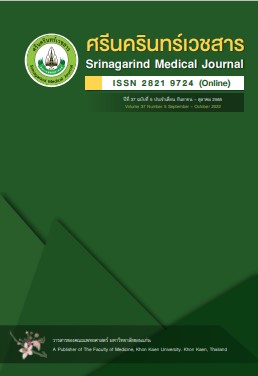การศึกษาปริมาณรังสีที่ผู้ป่วยได้รับบริเวณเลนส์ตาจากการตรวจสมองด้วยเครื่องเอกซเรย์คอมพิวเตอร์ 64 และ 128 สไลซ์
A Study of the Radiation Dose Received by Patients to the Lens of Eye from Brain CT with 64 and 128 Slice CT Systems
Abstract
วิธีการศึกษา: ติดอุปกรณ์วัดรังสีโอเอสแอลชนิด นาโนดอท (nanoDot) ที่เปลือกตาทั้ง 2 ข้างของผู้ป่วยที่เข้ารับการตรวจสมองด้วยเครื่องเอกซเรย์คอมพิวเตอร์ 64 สไลซ์ (19 ราย) และ 128 สไลซ์ (19 ราย) เพื่อวัดค่าปริมาณรังสีที่เลนส์ตาของผู้ป่วย
สรุป: ปริมาณรังสีเฉลี่ยที่ผู้ป่วยได้รับบริเวณเลนส์ตาจากการตรวจสมองด้วยเครื่องเอกซเรย์คอมพิวเตอร์ 64 สไลซ์และ 128 สไลซ์ มีค่าไม่เกินเกณฑ์ต่ำสุดที่จะทำให้เกิดต้อกระจกหรือเลนส์ตาขุ่นมัว ดังนั้น การใช้อุปกรณ์ป้องกันอันตรายจากรังสีจำเป็นต้องพิจารณาถึงตำแหน่งของการถ่ายภาพเพื่อไม่ให้บดบังอวัยวะที่ต้องการถ่ายภาพ
คำสำคัญ: ปริมาณรังสี, เลนส์ตา, เครื่องเอกซเรย์คอมพิวเตอร์, อุปกรณ์วัดรังสีโอเอสแอล นาโนดอท
Background and Objective: Brain scans using computed tomography can help to visualize abnormalities and the internal details of organ structure. However, the use of X-rays may have an effect on the lens of eye, which is a radiosensitive tissue. The goal of this study was to measure the radiation dose at the lens of patient's eyes during a computed tomography examination.
Methods: An optically stimulated luminescence dosimeters (OSL) nanoDot detector was attached to both eyelids of patients who underwent 64 slices CT brain scanner (n=19) and 128 slices CT brain scanner (n=19) to measure the radiation dose of the patient's eye lens.
Results: The mean radiation doses to the left and right eye lenses from a 64 slices CT scanner were 31.964 mGy and 31.913 mGy, respectively. The mean radiation doses from a 128 slices CT scanner for the left and right eye lenses were 33.237 mGy and 32.929 mGy, respectively. It was found that the radiation doses to eye lens from both sides were not significantly different (p<0.01). The radiation dose does not exceed the minimum threshold for cataract formation (500 mGy) and the lens opacity (500 - 2000 mGy).
Conclusions: The mean radiation dose delivered to patients' eye lenses during 64-slice and 128-slice CT brain examinations does not exceed the minimum threshold for cataracts or lens opacity. The use of radiation shielding should not obscure the organ to be imaged.
Keywords: radiation dose, lens eye, computed tomography, OSL nanodot


